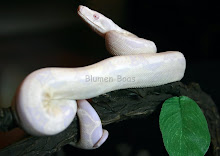Who's Your Daddy?
The short answer is that she doesn't have one! This is Caram, my female 2009 Boawoman Caramel produced by Sharon Moore. Research by Dr. Warren Booth (Department of Entomology, North Carolina State University) has now confirmed that Caram's mother had her litter via a process called Parthenogenesis. This is the first confirmed case of Parthenogenesis found in Boa Constrictors. Basically, Parthenogenesis means that there is no need for a male to be involved with the reproductive process, and the babies from her litter(s) inherit the mom's genes (a virgin birth if you will). The mother boa constrictor was not technically a virgin, since she had previously produced a litter sexually. In 2004, she produced a small litter via sexual reproduction with a male. After the male was removed and the female was housed alone, no additional litters were produced from 2005 through 2007. In the next 2 years, the female produced two litters of live offspring (2009 = 12, 2010 = 10), coincident with being housed and possibly copulating with up to four males. These litters were unusual because all of the offspring were female, and all exhibited a rare phenotype known as caramel, a recessive color trait expressed by the mother, but a gene not believed to be carried in the heterozygous state by the males that were with her. The scientists think boa females may therefore have the ability to alternate between sexual and asexual reproduction.
Male snakes’ cells have two Z chromosomes, while female snakes’ cells have a Z and a W chromosome. Yet in the study, all the female babies produced by asexual reproduction had WW chromosomes. Genetic tests confirmed that the babies are not related to any of the males that the female had courted with. Dr. Booth and other scientists extracted and analyzed DNA from skins shed by the mother, the males and the caramel-colored offspring. This DNA fingerprinting, functioning like a paternity test, determined that the offspring exhibited a sex chromosomal arrangement of WW. Caram not only has WW chromosomes, but so do the rest of litter from 2009 and another from 2010. Both litters were all female, and all of the offspring are half clones of their mother.
One other interesting fact about Caram and her littermates is that if Caram and her littermates can reproduce sexually, all offspring they produce will be female. They are genetically incapable of producing male offspring. Only from their female offspring can males be produced again. It will be interesting to watch Caram mature, and especially see what happens once she reaches breeding age. She is one special animal, that's for sure!
Here is a link to Dr. Booth's paper along with links to other write-up's around the web I used for this blog entry: Link1, Link2, and Link3.
Male snakes’ cells have two Z chromosomes, while female snakes’ cells have a Z and a W chromosome. Yet in the study, all the female babies produced by asexual reproduction had WW chromosomes. Genetic tests confirmed that the babies are not related to any of the males that the female had courted with. Dr. Booth and other scientists extracted and analyzed DNA from skins shed by the mother, the males and the caramel-colored offspring. This DNA fingerprinting, functioning like a paternity test, determined that the offspring exhibited a sex chromosomal arrangement of WW. Caram not only has WW chromosomes, but so do the rest of litter from 2009 and another from 2010. Both litters were all female, and all of the offspring are half clones of their mother.
One other interesting fact about Caram and her littermates is that if Caram and her littermates can reproduce sexually, all offspring they produce will be female. They are genetically incapable of producing male offspring. Only from their female offspring can males be produced again. It will be interesting to watch Caram mature, and especially see what happens once she reaches breeding age. She is one special animal, that's for sure!
Here is a link to Dr. Booth's paper along with links to other write-up's around the web I used for this blog entry: Link1, Link2, and Link3.
Labels: Boawoman Caramel, Caram, Parthenogenesis in Boa Constrictor




0 Comments:
Post a Comment
Subscribe to Post Comments [Atom]
<< Home